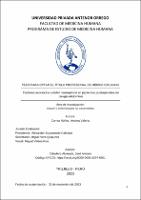Mostrar el registro sencillo del ítem
Factores asociados a dolor neuropático en pacientes postoperados de cirugía abdominal
| dc.contributor.advisor | Caballero Alvarado, José Antonio | |
| dc.contributor.author | Correa Núñez, Andrea Valeria | |
| dc.creator | Correa Núñez, Andrea Valeria | |
| dc.date.accessioned | 2023-12-07T15:00:28Z | |
| dc.date.available | 2023-12-07T15:00:28Z | |
| dc.date.issued | 2023 | |
| dc.identifier.uri | https://hdl.handle.net/20.500.12759/14051 | |
| dc.description.abstract | Objetivo: Determinar los factores asociados a dolor neuropático en pacientes postoperados de cirugía abdominal en el Hospital Regional Docente de Trujillo durante el periodo julio – agosto de 2023. Materiales y método: Se llevó a cabo un estudio transversal analítico, prospectivo, con pacientes atendidos en el servicio de cirugía general del Hospital Regional Docente de Trujillo durante el periodo julio – agosto de 2023. Se realizó una entrevista y revisión de historia clínica para identificar los factores asociados a dolor neuropático y se aplicó el cuestionario DN4 para determinar los casos. Resultados: Participaron 203 pacientes, de los cuales 90 (44.3%) presentaron dolor neuropático y 113 (55.7%) no lo presentaron. Al comparar los factores de asociación, solo se encontró relación significativa con el tipo de cirugía (RP: 1.68, IC 95% 1.10 – 2.55), tipo de procedimiento y diagnóstico. Conclusión: El dolor neuropático se presenta en el 44.3% de pacientes postoperados de cirugía abdominal, siendo el tipo de cirugía, diagnóstico y el tipo de procedimiento los únicos factores de riesgo asociado en este estudio | es_PE |
| dc.description.abstract | Objective: Determine the factors associated with neuropathic pain in post-abdominal surgery patients at Hospital Regional Docente de Trujillo during the period July - August 2023. Materials and method: A cross-sectional, prospective study was carried out with patients treated in the general surgery service of the Regional Teaching Hospital of Trujillo during the period July - August 2023. An interview and clinical history review was conducted to identify the factors associated with neuropathic pain and the DN4 questionnaire was applied to determine the cases. Results: There were 203 patients, of whom 90 (44.3%) had neuropathic pain and 113 (55.7%) did not. When the association factors were compared, only significant association were found with the type of surgery (OR: 1.68, 95% CI 1.10 - 2.55), diagnosis and type of procedure. Conclusion: Neuropathic pain is present in 44.3% of postoperative abdominal surgery patients, with the type of surgery, diagnosis and type of procedure being the only associated risk factors in this study. | es_PE |
| dc.description.uri | Tesis | es_PE |
| dc.format | application/pdf | es_PE |
| dc.language.iso | spa | es_PE |
| dc.publisher | Universidad Privada Antenor Orrego | es_PE |
| dc.relation.ispartofseries | T_MED_3601 | |
| dc.rights | info:eu-repo/semantics/openAccess | es_PE |
| dc.rights.uri | https://creativecommons.org/licenses/by/4.0/ | es_PE |
| dc.source | Universidad Privada Antenor Orrego | es_PE |
| dc.source | Repositorio Institucional - UPAO | es_PE |
| dc.subject | Dolor neuropático | es_PE |
| dc.subject | Postoperatorio | es_PE |
| dc.subject | Cirugía abdominal | es_PE |
| dc.title | Factores asociados a dolor neuropático en pacientes postoperados de cirugía abdominal | es_PE |
| dc.type | info:eu-repo/semantics/bachelorThesis | es_PE |
| thesis.degree.level | Título Profesional | es_PE |
| thesis.degree.grantor | Universidad Privada Antenor Orrego. Facultad de Medicina Humana | es_PE |
| thesis.degree.name | Médico Cirujano | es_PE |
| thesis.degree.discipline | Medicina Humana | es_PE |
| dc.subject.ocde | https://purl.org/pe-repo/ocde/ford#3.02.27 | es_PE |
| renati.advisor.orcid | https://orcid.org/0000-0001-8297-6901 | es_PE |
| renati.author.dni | 71337078 | |
| renati.advisor.dni | 18886226 | |
| renati.type | https://purl.org/pe-repo/renati/type#tesis | es_PE |
| renati.level | https://purl.org/pe-repo/renati/level#tituloProfesional | es_PE |
| renati.discipline | 912016 | es_PE |
| renati.juror | Bustamante Cabrejos, Alexander | |
| renati.juror | Vera Quipuzco, Miguel | |
| renati.juror | Villena Ruíz, Miguel | |
| dc.publisher.country | PE | es_PE |
Ficheros en el ítem
Este ítem aparece en la(s) siguiente(s) colección(es)
-
Medicina Humana [2969]




